Authentic Italian Pizza Recipes to Make at Home

If you love the idea of making traditional Italian pizza at home, you’re in the right place. Creating the perfect Italian pizza is more than just following a recipe. It’s an art form. It combines tradition, amazing flavors, and the joy of homemade meals. Enjoy crisp crusts, homemade sauce, and classic toppings. Now, authentic Italian pizza can be made in your kitchen.
Imagine tasting Traditional Italian Pizza fresh from your oven. Embark on this flavorful journey to learn the secrets of Italian pizza. You’ll master recipes with delicious homemade sauce and that special Italian zest. So, get your kitchen ready. We’re about to make some pizza magic!
Key Takeaways
- Authentic Italian pizza recipes can be replicated at home with the right guidance.
- Creating homemade pizza sauce is essential for true Italian flavors.
- Fermenting dough for at least 24 hours achieves a traditional texture.
- Cook times may vary, but a high heat of 250 °C (480 °F) for 10 to 15 minutes is standard.
- Each classic pizza like Margherita and Neapolitan has specific ingredient ratios for authenticity.
- Subtleties in ingredient choice, such as San Marzano tomatoes, make a big difference.
- Nutritional values can be controlled when making pizza at home.
The Art of Italian Pizza Dough
Learning how to make Italian Pizza Dough Recipes starts with knowing the classic steps and must-have ingredients. This knowledge is key for making Neapolitan Pizza that is thin and crispy. Achieving that perfect texture comes from mixing and preparing the ingredients just right.
The secret to amazing Pizza Dough Recipes lies in using the correct flour. Mixing ‘00’ flour with all-purpose flour gives the right balance for stretchy yet crisp dough. This combination, along with 65% water, makes dough that’s easy to handle. It also helps create that light, airy crust Neapolitan Pizza is famous for.
To make traditional Italian Pizza Dough Recipes at home, start by mixing 150 grams of ’00’ flour with 150 grams of all-purpose flour. Then, add 8 grams of fine sea salt and 2 grams of yeast. Next, mix in 8 grams of olive oil and 150 ml of water slowly until it’s all combined. Knead the dough until it’s smooth, then let it rise for 3 to 4 hours. This helps develop the taste and texture.
| Ingredient | Quantity | Function |
|---|---|---|
| ’00’ Flour | 150 grams | Provides elasticity & fine texture |
| All-Purpose Flour | 150 grams | Enhances dough structure |
| Extra-virgin Olive Oil | 8 grams | Adds flavor and moisture |
| Fine Sea Salt | 8 grams | Seasoning |
| Active Dry Yeast | 2 grams | Facilitates fermentation |
| Water | 150 ml | Hydrates the dough |
After the dough has risen, shape it with your hands to keep it fluffy. Don’t use a rolling pin because that can press the air out. Heat your oven as high as it can go, like a real Italian pizza oven. Bake it for about 12 minutes or until the edge looks crisp and golden.
Whether you’re just starting or have been cooking for years, making Italian Pizza Dough Recipes is an adventure. You can create anything from a basic Margherita to an exciting Vodka Pizza. But, no matter what, it all starts with good, traditional dough. This dough respects the age-old Neapolitan Pizza process.
Creating Your Homemade Pizza Sauce
Starting your Italian Pizza Recipes at home? It all begins with the sauce. A real homemade pizza sauce is the base for a true pizza experience. It finds the perfect spot between easy and full of flavor.

Crushing Tomatoes for Freshness
For a fresh sauce, the tomatoes matter a lot. Pick high-quality San Marzano tomatoes. They’re sweet and not too acidic, perfect for pizza sauce. Crush them by hand or food processor for a sauce that’s fresh and textured.
Seasoning with Authentic Italian Herbs
Add real Italian herbs like fresh basil and dried oregano. Basil gives freshness, and oregano adds an earthy flavor. These herbs improve the taste and make your kitchen smell like Italy.
Garlic Infusion for Rich Flavor
Garlic adds depth to your sauce. Always use fresh minced garlic, not powder. Cook it slightly in olive oil before adding it to the sauce. This way, the garlic’s rich flavor blends in perfectly without taking over.
| Ingredient | Quantity | Importance |
|---|---|---|
| San Marzano Tomatoes | 1 can | Base for sauce |
| Fresh Basil | To taste | Flavor enhancement |
| Dried Oregano | To taste | Aromatic presence |
| Fresh Garlic | 1 clove | Depth of flavor |
| Extra Virgin Olive Oil | To taste | Smooth blending |
Making your own pizza sauce adds a personal touch to your pizza. Each slice shows your love for cooking.
Mastering the Margherita Pizza
To create the perfect Margherita Pizza, you need to know how to pick and put together your ingredients. This will help you make an Italian pizza that’s just like the ones from Italy.
Choosing the Right Cheese
Choosing the right cheese is crucial for a genuine Margherita Pizza. Go for dry mozzarella because it melts well without making the pizza soggy. You should use 2 oz of this cheese per pizza. This ensures your pizza is perfectly browned on top, without overpowering the rest of the flavors.
Layering for Optimal Flavor
How you layer the pizza is very important. Start with a homemade tomato sauce, seasoned with kosher salt and fresh basil purée. This base is what makes it taste like Traditional Italian Pizza. Then, add your mozzarella cheese evenly. This way, every slice is a delicious mix of flavors.
The Basil: Fresh vs Dried
Traditional recipes use fresh basil for a bright, peppery flavor. But, dried basil works if you prefer a milder taste. Add fresh basil before baking for a bit of crunch. Or, add it after baking to keep its flavor and smell strong.
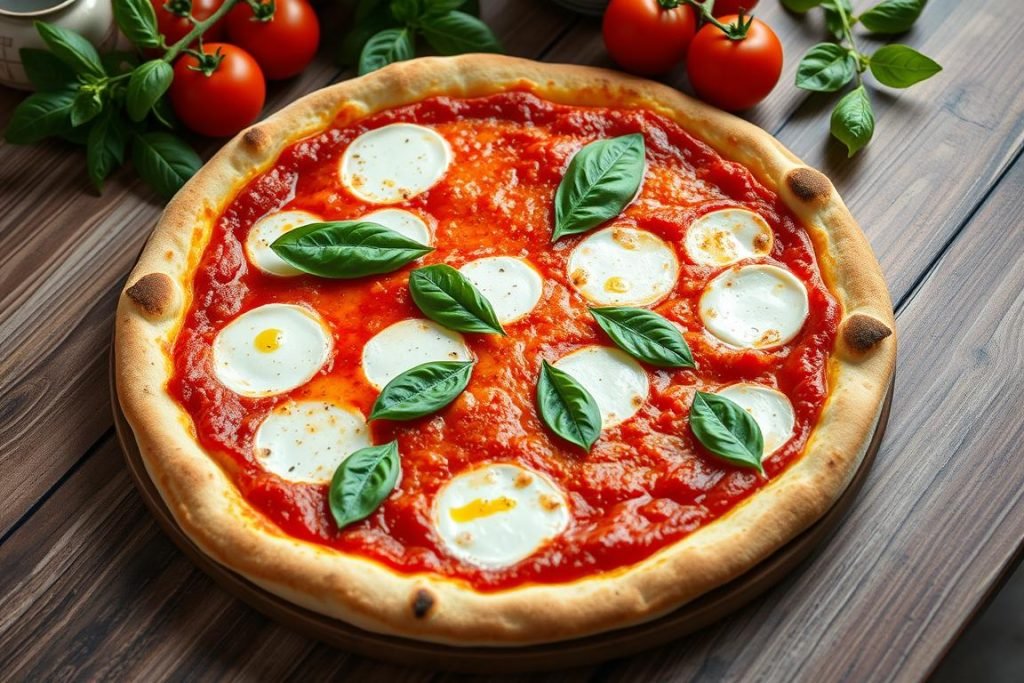
Understanding these details will make your Italian pizza stand out. To make the best Margherita Pizza, choose top-notch ingredients and use them carefully. It’s the little things that will show you have mastered the art of pizza.
The Iconic Neapolitan Pizza
If you love Traditional Italian Pizza, you need to know how to make Neapolitan Pizza. This special dish follows strict rules. This ensures it reflects true Italian cooking. Let’s explore how this pizza gets its unique flavor and texture.

Making authentic Neapolitan Pizza starts with its dough. This base sets it apart from other pizza types. The dough combines water, quality 00 flour, a bit of yeast, and sea salt. It should be smoothly kneaded then rested at a cool temperature.
The dough’s fermentation process is key. It rests for at least 2 hours to develop flavor and texture. After this, it’s divided into 250g balls. These balls then rest again. This makes sure the crust is light and airy when baked.
The toppings for a Neapolitan Pizza are simple yet specific. It uses tomato sauce, fresh mozzarella cheese, basil leaves, and extra virgin olive oil. You won’t find heavy meats or extra toppings here. This ensures the pizza’s balance and delicacy.
Baking requires a very hot wood-fired oven. This type of oven cooks the pizza quickly, adding a unique char. For those without this oven, use the highest temperature in a home oven. This is crucial for getting that authentic taste and texture.
The Neapolitan Pizza is deeply traditional and complex in a simple way. It offers a real Italian taste experience. It’s also a challenge that any lover of Italian Pizza Recipes would enjoy. So, get your pizza peel ready and dive into traditional Italian pizza making.
Wood-Fired Pizza at Home Without the Wood-Fired Oven
Making wood-fired pizza at home might seem tough without the right oven. But, with easy steps and the perfect tools, you can make it happen. Using a good pizza stone, you can enjoy smoky, crisp pizza just like in Italy, right from your kitchen oven.
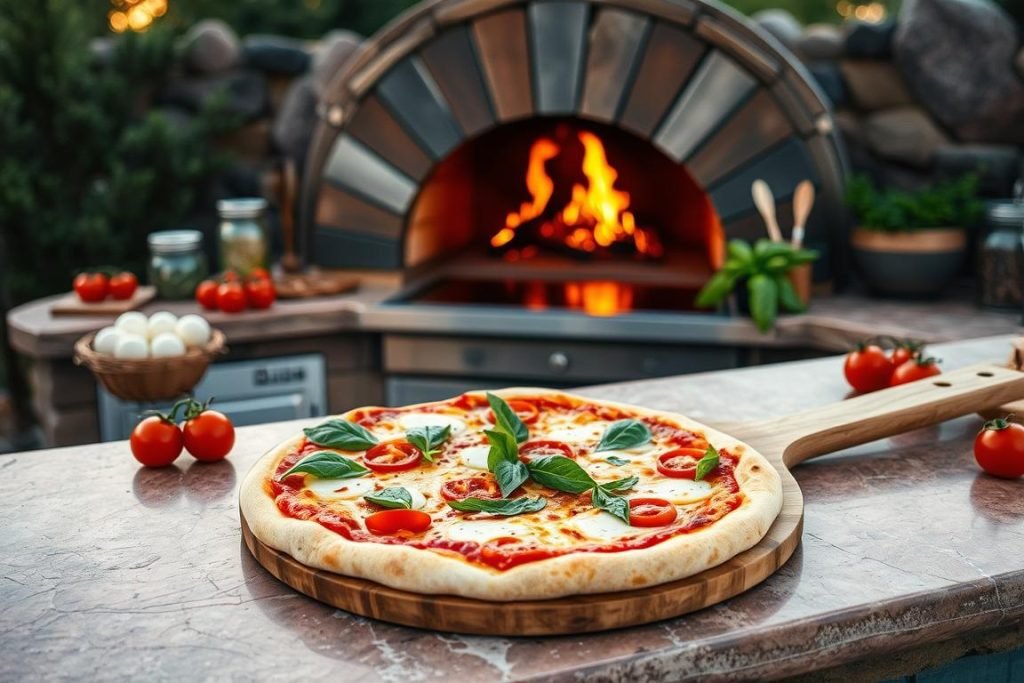
To start, get a pizza stone. It doesn’t cost much, about $15. This stone heats up evenly, acting like the floor of a wood oven. Make sure to heat your pizza stone in the oven at its highest, around 500°F (260°C), for 30 minutes before you bake.
- Pizza Dough Preparation:
- Knead your dough for 5-10 minutes to make it just right.
- Let it rise at room warmth for 4 hours, or in the fridge for 3 days for slow rising.
- Split the dough into 340-gram balls and leave them at room temperature for 2 hours before baking.
Roll the dough into a 16-inch circle and put your favorite toppings on it. For a real Italian taste, try salami and ricotta or potato and rosemary. Add a bit of olive oil and some kosher salt on top.
| Step | Action | Time |
|---|---|---|
| 1 | Preheat the oven with the pizza stone inside | 1 hour |
| 2 | Bake pizza at the highest temperature | About 5 minutes |
Your pizza will have a crispy bottom and perfectly melted cheese with this method. It’s a simple way to get wood-fired pizza flavor at home. Plus, it’s a fun and satisfying project.
Adding fresh basil leaves right after baking makes the pizza even better. High heat and quick baking lock in the flavors and create a wood-fired texture.
Tip: Using cornmeal under the pizza helps with handling and makes the crust crunchier. Also, mixing dough with a strong mixer like a Bosch or KitchenAid gives great results.
Perfecting the Napoletana Pizza Experience
Creating the perfect Napoletana pizza starts with the dough. This Italian classic focuses on high-quality, simple ingredients. Mastering the measurements and timing can turn your home into a pizza lover’s paradise.
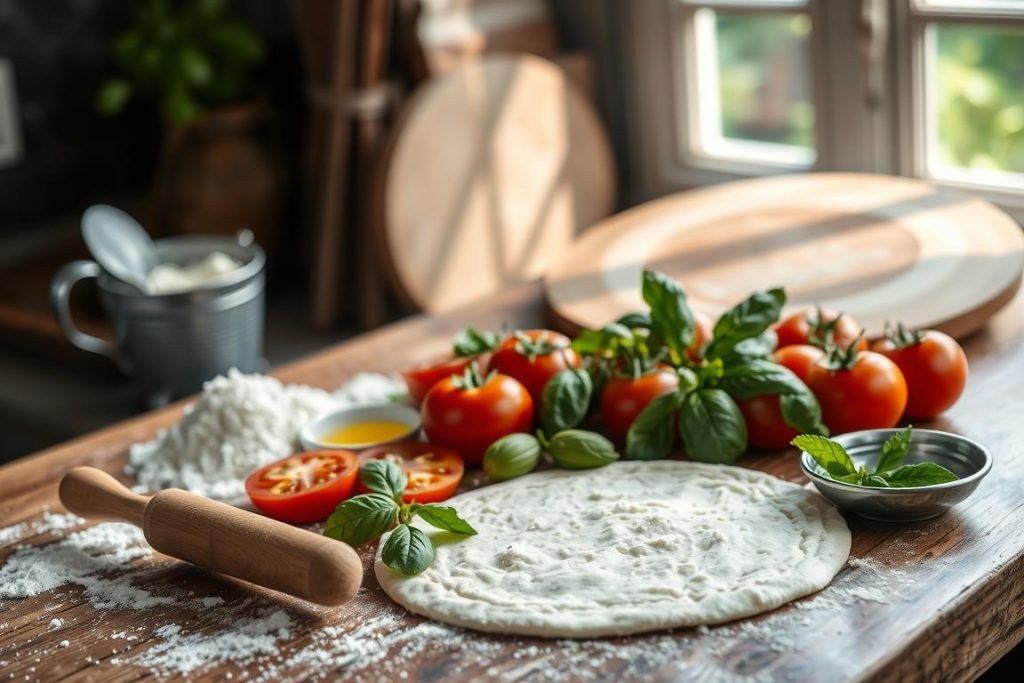
The journey begins with the dough. It mainly uses high-gluten flour. The right mix is: 100% flour, 69.1% water, 2.2% salt, and 0.54% yeast. These proportions create the famous thin center and airy crust.
Mixing the dough right is key. Mix it for about 8 to 12 minutes until it’s smooth and stretchy. After mixing, let it ferment slowly in the fridge for 24 hours. This slow rise makes the flavor deeper and the crust easier to digest.
- Cold water in the mix helps control the dough’s rise, ensuring even structure.
- After resting, divide the dough into 220-230 gram balls. This is perfect for a 12-inch pizza.
- Let the dough rise in a warm place until it doubles in size, about 2 hours, before shaping.
Preheat your oven with a pizza stone to 550°F. This is the highest setting for most home ovens. It copies the heat of Italian pizza ovens. Heat the stone for at least 45 minutes to make sure it’s evenly hot.
When shaping the dough, be gentle. This keeps the air bubbles in the rim, making it puff up in a hot oven. The cooking is fast – just 60 to 90 seconds at high heat. This chars the edges and melts the toppings just right.
For true Napoletana style, choose toppings wisely. Go for San Marzano tomatoes and fresh mozzarella. Use just enough to avoid a soggy crust.
Understanding these details and timings makes the Napoletana pizza experience special. Every bite shows the Italian tradition of culinary excellence.
Essential Tips for Selecting Pizza Toppings
When making an Italian pizza at home, the right pizza toppings are key. These ingredients shape the pizza’s flavor and texture. They honor the tradition of Italian pizza. Follow these tips to pick the best toppings for your pizza.
Sourcing Ingredients for Authenticity
Start by finding fresh, top-quality ingredients. For classic Italian pizzas like the Margherita Pizza, use high-grade mozzarella, San Marzano tomatoes, and fresh basil. These essentials give your pizza the authentic Italian flavor and feel it deserves.
Balancing Flavors and Textures
Creating your pizza’s perfect taste and feel involves mixing toppings well. A good Margherita Pizza has just enough of each topping. It doesn’t overload the crust. Italian pizzas focus on the depth of flavors, not the quantity of toppings.
Topping Variations to Try
Trying different toppings can make pizza making fun and creative. Beyond the Margherita, you might add prosciutto and arugula or even buffalo mozzarella and rosemary. Italy’s regions offer many topping ideas. They can inspire your next pizza adventure.
Here’s how to layer toppings for great cooking results:
| Pizza Style | Ingredient Layering Order | Specific Topping Examples |
|---|---|---|
| Classic Italian | Crust, Sauce, Cheese, Toppings | Margherita: Tomato Sauce, Mozzarella, Basil |
| Chicago Deep Dish | Crust, Cheese, Toppings, Sauce | Supreme: Mozzarella, Pepperoni, Veggies, Sauce on Top |
| Napoletana | Crust, Sauce, Toppings, Cheese | Anchovies, Capers, Mozzarella, Olive Oil |
The crust’s thickness and the oven type can change the final pizza. Experiment to see what fits best. Stick to traditional Italian pizza methods for the best results.

With these tips, you’ll master Italian Pizza Recipes at home. Every pizza will delight your senses and bring Italy to your table, one slice at a time.
Italian Pizza Recipes
Starting your journey with Italian pizza recipes is exciting, even from your own kitchen in America. You’ll easily adapt these magical recipes with the right tools and tips. They keep their Italian spirit but use ingredients you can find nearby.
Adapting Recipes for American Kitchens
You may not get to pick fresh ingredients in Naples. But there are good local substitutes. Use fire-roasted tomatoes for sauces and good all-purpose flour instead of Tipo 00. These changes still give amazing results.
Adding a pizza stone and wooden peel makes a big difference. It makes the crust crispy like in Italy. With a hot oven at 550 degrees F, your pizza will be perfect.
Exploring Regional Italian Pizza Variations
Italian pizza comes in many styles. Each one reflects the tastes and traditions of its region. Neapolitan pizza is thin and simple with mozzarella and basil. It shows that less can be more.
Roman pizza is thicker with lots of toppings. It offers a different experience. Learning these variations expands your pizza-making skills.
Step-by-Step Guides to Authentic Pizzas
Our step-by-step guides make pizza making easier. Whether it’s the dough or the toppings for a Margherita. Following these steps, gathered from experts and Italian trips, is key.
Each step, from kneading to baking, is crucial. They ensure your pizza has a golden crust, bubbling cheese, and fresh flavors. This goes for pizzas like Margherita and the topping-rich Neapolitan.
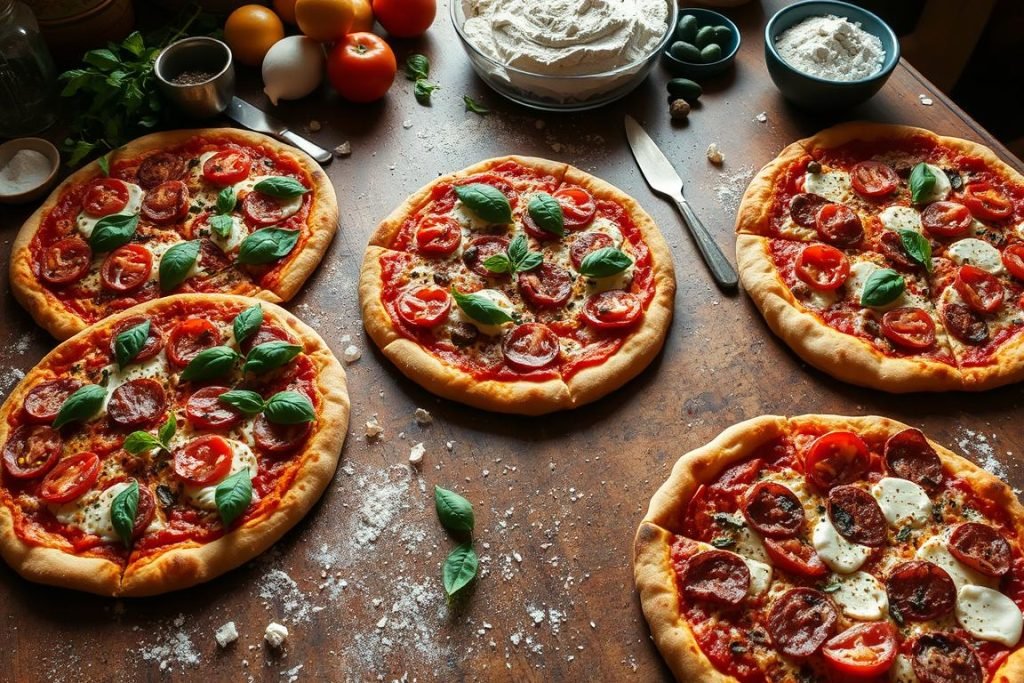
| Pizza Type | Crust Type | Key Ingredients | Cooking Time |
|---|---|---|---|
| Neapolitan Pizza | Thin, soft with crisp edges | San Marzano tomatoes, fresh mozzarella, fresh basil | 12 minutes at 550 degrees F |
| Margherita Pizza | Thin, slightly crispy | Tomato sauce, mozzarella cheese, basil | 10 minutes at 550 degrees F |
For anyone just starting or already loving cooking, trying these recipes is fun. They let you dive into Italy’s rich food culture. Every pizza night becomes a tribute to Italy’s culinary traditions.
Choosing the Right Italian Pizza Oven for Your Home
Choosing the right Italian pizza oven is key for authentic homemade pizza. You may want wood-fired pizza’s rustic charm or a modern oven’s convenience. Your choice will shape your pizza nights.
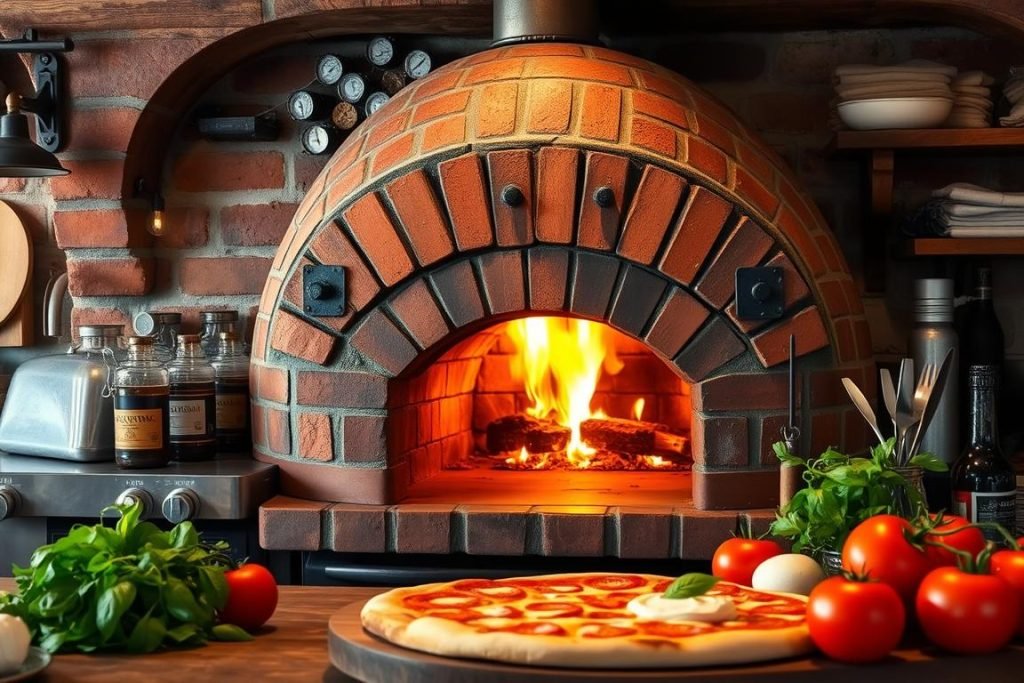
If you’re looking at wood-fired pizza ovens, know the differences between home models. Your oven choice affects heat distribution and handling larger pizzas.
| Model | Weight | Opening Size | Heat Distribution |
|---|---|---|---|
| Gozney Roccbox | 20kg | Smaller | Intense, back to front |
| Gozney Dome | 60kg | Wider | Evenly distributed |
| Gozney Arc XL | 30kg | Wide | Upward channel for even heat |
Considering a portable model? The Gozney Roccbox is great for those on the go. Its smaller opening may limit pizza peel size though.
The Gozney Dome, on the other hand, suits those wanting more than pizza. Its wider opening fits larger pizzas and different dishes. But, it’s less easy to move around.
The Gozney Arc XL strikes a balance. It’s good for various pizza sizes and ensures an even heat distribution. This is great for that crispy crust you want.
Choosing a quality Italian pizza oven is crucial for an authentic experience. Decide between a wood-fired or gas-fired model. Wood-fired ovens offer authentic flavor but take longer to heat. Gas-fired models, like Fontana Forni’s, heat quickly and clean easily.
Your Italian pizza oven should fit your lifestyle, space, and cooking needs. This ensures your pizzas are always delicious and perfectly textured.
Conclusion
We’ve traveled through the world of Italian pizza, celebrating its tradition and artistry. Step by step, from perfecting dough to making homemade sauce, we’ve learned the importance of technique and precision. By making pizza several times, we’ve seen how sticking to specific flour and recording details like rising times makes a big difference. It’s these details that make a pizza so authentic, it feels like Italy right at home.
Ingredients matter a lot too. From the flavorful San Marzano tomatoes to the creamy fiore di latte mozzarella from Vincenzo’s, each has its place. Embarking on this journey is more than just cooking; it’s an affordable luxury. Using luxurious mozzarella di Bufala or fresh basil enhances the pizza. Yet, perfecting Traditional Italian Pizza is not just about following recipes. It’s also about adding your unique twist through practice and love.
Vincenzo’s pricing shows making Italian pizza at home can save money, even in 2023. And by looking at places like Lombardi’s Pizza, we appreciate the legacy of Italian Pizza even more. It’s not all about how it looks or the toppings used. Each pizza tells a story with its flavors, inviting us to explore Italian culture, one delicious piece at a time.